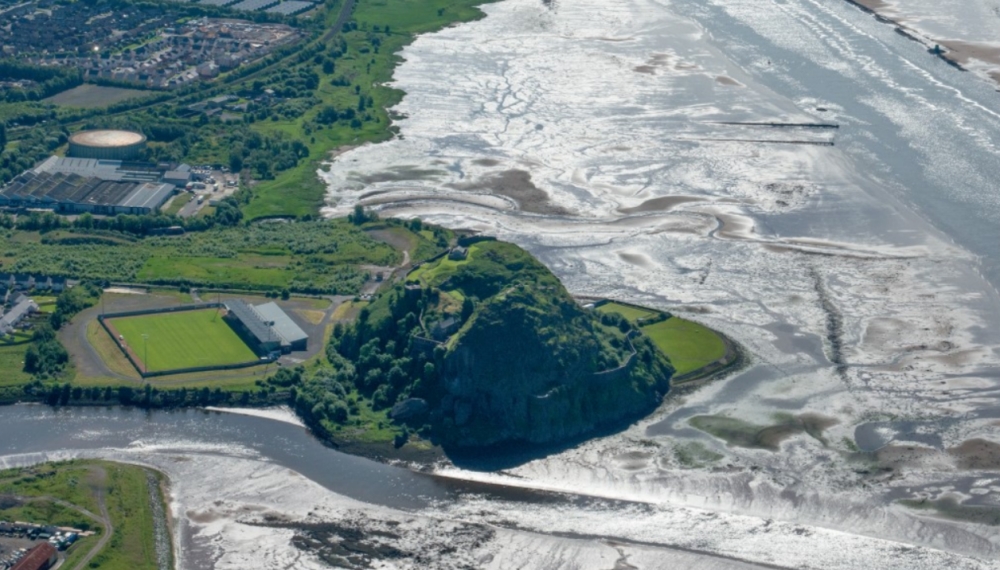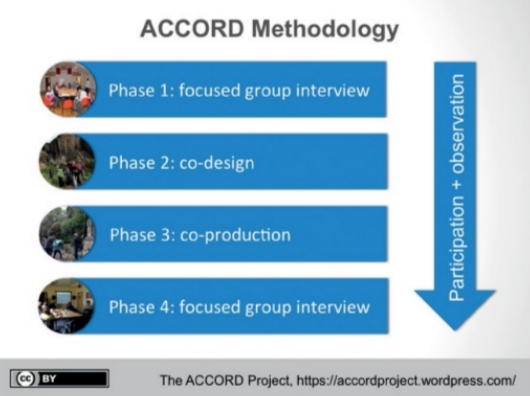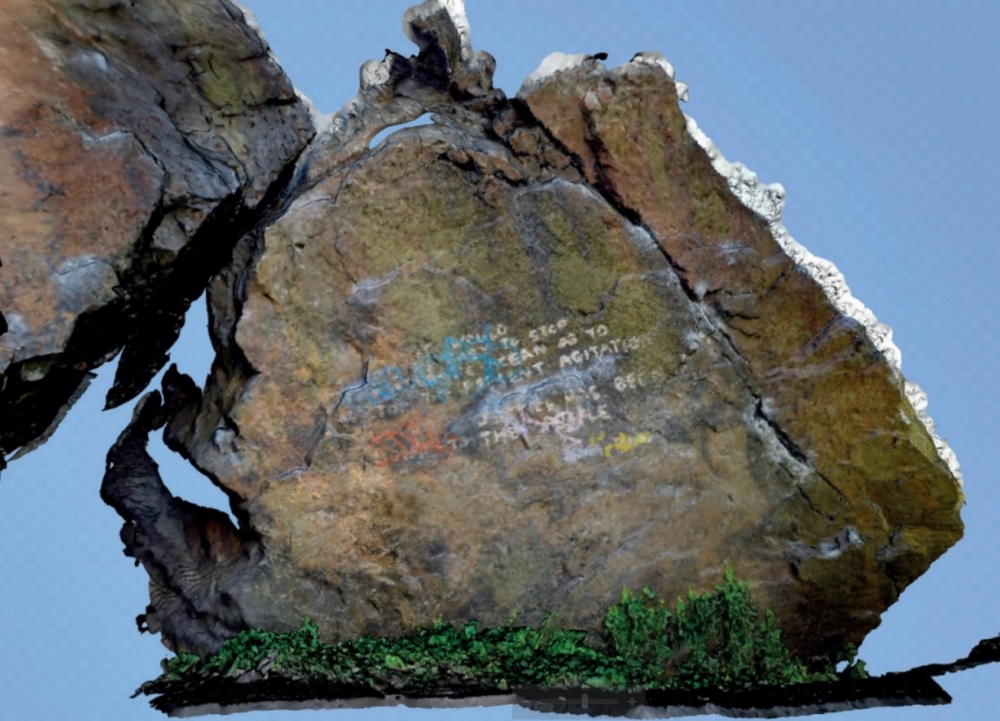Conservation, climbing and graffiti
Participatory methodologies, like those used in dealing with the marginalised heritage at Dumbarton Rock, can provide the basis for sensitive management and conservation planning.

|
| Aerial view of Dumbarton Rock and Castle (Crown Copyright: Historic Environment Scotland) |
| ‘I’ve been going on for years about Dumbarton Rock being one of our finest examples of modern sporting heritage, a kind of living history and an example of community ownership.’ Climber at Dumbarton Rock. |
Dumbarton Castle is a nationally significant heritage site in the care of Historic Environment Scotland, the non-departmental public body responsible for the care and promotion of Scotland’s historic environment. It is a locale laden with other heritage values, in particular those expressed in the opening quote from one of the climbers associated with Dumbarton Rock, the volcanic plug on which the castle is located. In this article we discuss how diverse heritage values can be identified and accommodated within heritage management and conservation planning. In particular, we focus on the community participatory methodologies developed by the ACCORD project,[1] and show how these can shed light on hidden or marginalised forms of value.

|
| Diagram showing stages in the ACCORD methodology (Photo: ACCORD, CC-BY). |
Once the capital of the early medieval Kingdom of Strathclyde, Dumbarton Rock remained a politically and tactically important place until the 19th century. In terms of extant structures, the castle is made up of military buildings and fortifications dating mainly to the 17th and 18th centuries (Canmore ID 43376). Many of the buildings are listed and the entire rock is a scheduled monument. In addition to protection and conservation, the castle is open to the public. Visitors approach from the eastern side of the rock surrounded by mown grass and picnic benches.
In contrast, the northern and western faces of the rock are approached along an overgrown, unsignposted path. This leads to a dramatic landscape of cliffs and boulders looking out on post-industrial landscapes on the confluence of the Clyde and Leven Rivers. As already noted, this side of the rock is an important climbing and bouldering site (see http://www.dumby.info). It has been subject to extensive graffiti, ranging from inscribed names and dates, and later political symbols and slogans, to colourful, painted tags and throw ups (types of graffiti).
In 2012, the forms of value associated with these varied activities created tensions when, at the request of a local councillor, Historic Scotland initiated a campaign to clean the painted graffiti.[2] In response, a number of the climbers, including two of the authors of this paper (JH and JSW), expressed concern about loss of the graffiti and the potential impact of the cleaning process on climbing routes. Subsequent consultation resulted in a selective cleaning campaign that left certain pieces of graffiti of special significance to climbers intact (Hale et al, 2017).
Graffitigate, as it is humorously referred to by some of the climbers, highlights changes in how heritage bodies respond to community concerns, in this case with rapid consultation and modification of the conservation strategy. Likewise, increasing recognition of (some forms of) graffiti marks a shift in the scope of authorised heritage. The situation at Dumbarton Rock also highlights the ongoing difficulties that heritage bodies face in dealing with the complexities of cultural significance, particularly in the realm of social and communal values. Initially the site’s significance in terms of Scottish climbing heritage appears to have gone undetected, or at least been underestimated. This raises questions about how heritage organisations can better understand the fluid and often contested ‘social values’ of heritage places, defined here as the significance of heritage to contemporary communities, including people’s sense of identity, belonging, attachment and place (Jones, 2016).
The ACCORD project provides an example of how community participatory methods can shed light on the social values of heritage places. The project examined the opportunities and implications of collaborative, community-based, digital recording and modelling, using the techniques of photogrammetry and reflectance transformation imaging, with occasional use of laser scanning (Jeffrey et al, 2015). Using co-design and co-production, the project team worked with 10 community heritage groups across Scotland to create 3D records and models of heritage places of significance to them. Popular in a range of design, planning and healthcare environments, these methodologies are intended to decentre traditional relationships of power, control and expertise between researchers and volunteers, or ‘professionals’ and ‘non-professionals’.
A distinctive aspect of the ACCORD project is that ‘co-design’ encouraged community participants to take an active role in selecting recording ‘targets’, with particular attention to the significance of heritage places, and the social and communal values associated with them. At the same time, the project team explored the impact of community co-design and co-production on the value and authenticity of both the digital models and their original counterparts. For this purpose, we used qualitative research methods associated with rapid or focused ethnography. Our work with each group started and finished with focused group interviews, which acted as points of intensive discursive enquiry where background knowledge could be obtained, and concepts and experiences relevant to the project explored. We also used participant observation during the co-design and co-production of the digital records and models, which facilitated intensive observation of these practices and the values that mediated them.
In July 2015, the ACCORD team worked with seven climbers at ‘Dumby’, as they call Dumbarton Rock. The results of this work provide insights into the values associated with the place and demonstrate the potential of the methodologies involved. Dumby has been at the forefront of the development of Scottish rock climbing since the 1960s. The values surrounding it are linked to the volcanic geology and the styles of climbing it necessitates. In particular, the way it fractures requires the use of many pressure holds. It offers many difficult and challenging routes; climbers regard it as a ‘yardstick’, ‘a place to push your limits’. These ‘use values’ contribute to its social significance among the climbing fraternity.
The significance of Dumby is also rooted in the unique character and atmosphere that define its sense of place. It is seen as a captivating place of raw beauty informed by the changing weather and tides. At the same time it is associated with a gritty character linked to the industrial heritage of Dumbarton, particularly as this recent (but now often disused and decommissioned) industrial infrastructure provides a striking photographic backdrop to many iconic images of significant ‘first ascents’. The hard graft of industry offers an analogy for climbing, which also ‘requires a graft and an industry’. The graffiti that marks the rocks and the detritus left by local revellers add to this grittiness. While much of the graffiti is produced by others, in particular the recent colourful tags, it has come to define iconic climbing routes and ‘problems’ (as in the case of ‘Eagle Rock’ or ‘The Shield’). The relationship between the graffiti and climbing routes is now inscribed in climbing guides.
There is a vigorous sense of community among the climbers who frequent Dumbarton Rock, and strong expressions of attachment, loyalty and ownership. This is founded on shared practice and appreciation of place rather than residence. The Dumby website and social media have created cohesion among those who climb there in recent years. There is a rich tradition of oral history, which creates a sense of generations of climbers, including leading figures in Scottish and world climbing. The graffiti adds a further dimension in regard to continuity of place, ranging in date from at least the 19th century to the present day.
The nationalist graffiti is singled out by some as part of the counter-culture of Dumby, with ‘Saor Alba’ (‘Free Scotland’) inscriptions appearing at different times, including some dating from the 1979 Scottish referendum.
Participatory methodologies like those used in the ACCORD project can provide the basis for sensitive management and conservation planning. Indeed, in 2016 Historic Environment Scotland asked the ACCORD team to provide an account of its significance in terms of climbing heritage for the social value section of the statement of cultural significance for Dumbarton Rock. This should ensure continuing official recognition of the symbolic importance of the site for Scotland’s climbing heritage. The attendant danger is that such inscription risks fixing and objectifying certain kinds of values.
One of the key findings of the ACCORD project pertains to the dynamic processes and practices involved in valuing heritage places. In particular, the act of participatory community recording, in this case using digital technologies, has the potential to enhance the values associated with the heritage places they represent, and in some cases even create new forms of value (see Jones et al, 2017). This dynamic creates dilemmas that both academics and heritage professionals continue to grapple with, but which will require iterative forms of heritage practice capable of recognising the fluid and complex values involved in the production of heritage.

|
| ACCORD work in progress: a photogrammetric model of Pongo boulder (Photo: ACCORD, CC-BY). |
References
- [1] The ACCORD project (Archaeology Community Coproduction of Research Data, 2014-16) was led by Glasgow School of Art in association with University of Manchester, the Royal Commission on the Ancient and Historical Monuments of Scotland and Archaeology Scotland. It was funded by the Arts and Humanities Research Council under Grant AH/ L007533/1.
- [2] Historic Scotland and the Royal Commission on the Ancient and Historical Monuments of Scotland merged in 2015 to create Historic Environment Scotland.
- The digital data and models resulting from the ACCORD project, along with statements of social value, have been permanently archived with Archaeology Data Service (doi: https://doi.org/10.5284/1042733).
- Hale, Alex, Alison Fischer, John Hutchinson, Stuart Jeffrey, Siân Jones, Mhairi Maxwell, and John Stewart Watson (2017) ‘Disrupting the Heritage of Place: how counter archaeologies were practiced by the ACCORD Project at Dumby, Scotland’, World Archaeology 49(3)
- Jeffrey, Stuart, Alex Hale, Cara Jones, SiânJones, and Mhairi Maxwell (2015) ‘The ACCORD project: archaeological community co-production of research resources’ in Proceedings of the 42nd Annual Conference on Computer Applications and Quantitative Methods in Archaeology, CAA 2014, edited by François Giligny, François Djindjian, L Costa, Paola Moscati and S Robert, 1-7. Paris: CAA
- Jones, Siân (2016) ‘Wrestling with the Social Value of Heritage: problems, dilemmas and opportunities’ Journal of Community Archaeology and Heritage, 4:1
- Siân Jones, Stuart Jeffrey, Mhairi Maxwell, Alex Hale and Cara Jones (2017) ‘3D Heritage Visualisation and the Negotiation of Authenticity: the ACCORD project’, International Journal of Heritage Studies, 24(4)
This article originally appeared in IHBC’s Context 155, published in July 2018. It was written by:
- Siân Jones, Division of History and Politics, University of Stirling
- Alex Hale, Historic Environment Scotland, Edinburgh
- Stuart Jeffrey, School of Simulation and Visualisation, Glasgow School of Art
- John Hutchinson, School of Geographical and Earth Sciences, East Quadrangle, University of Glasgow
- Mhairi Maxwell, V&A Dundee
- John Stewart Watson, Stone Country Press, Glasgow
--Institute of Historic Building Conservation
Related articles on Designing Buildings Wiki
IHBC NewsBlog
Old Sarum fire in listed (& disputed) WW1 Hangar - Wiltshire Council has sought legal advice after fire engulfed a listed First World War hangar that was embroiled in a lengthy planning dispute.
UK Antarctic Heritage Trust launches ‘Virtual Visit’ website area
The Trust calls on people to 'Immerse yourself in our heritage – Making Antarctica Accessible'
Southend Council pledge to force Kursaal owners to maintain building
The Council has pledged to use ‘every tool in the toolbox’ if urgent repairs are not carried out.
HE’s Research Magazine publishes a major study of the heritage of England’s suburbs
The article traces the long evolution of an internal programme to research 200 years of suburban growth
IHBC Context 183 Wellbeing and Heritage published
The issue explores issues at the intersection of heritage and wellbeing.
SAVE celebrates 50 years of campaigning 1975-2025
SAVE Britain’s Heritage has announced events across the country to celebrate bringing new life to remarkable buildings.
IHBC Annual School 2025 - Shrewsbury 12-14 June
Themed Heritage in Context – Value: Plan: Change, join in-person or online.
200th Anniversary Celebration of the Modern Railway Planned
The Stockton & Darlington Railway opened on September 27, 1825.
Competence Framework Launched for Sustainability in the Built Environment
The Construction Industry Council (CIC) and the Edge have jointly published the framework.
Historic England Launches Wellbeing Strategy for Heritage
Whether through visiting, volunteering, learning or creative practice, engaging with heritage can strengthen confidence, resilience, hope and social connections.














